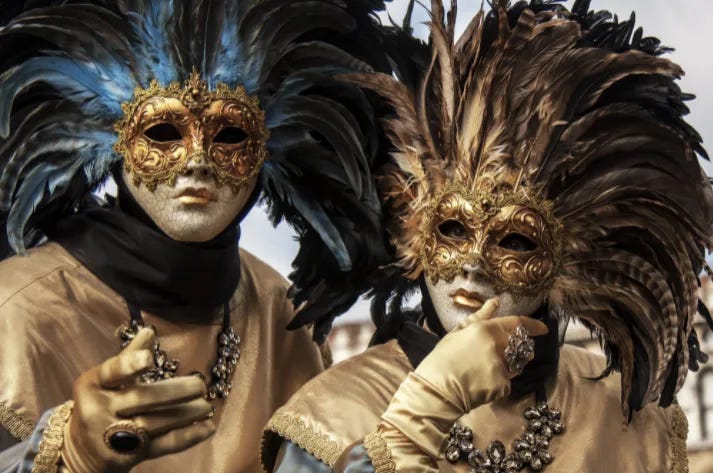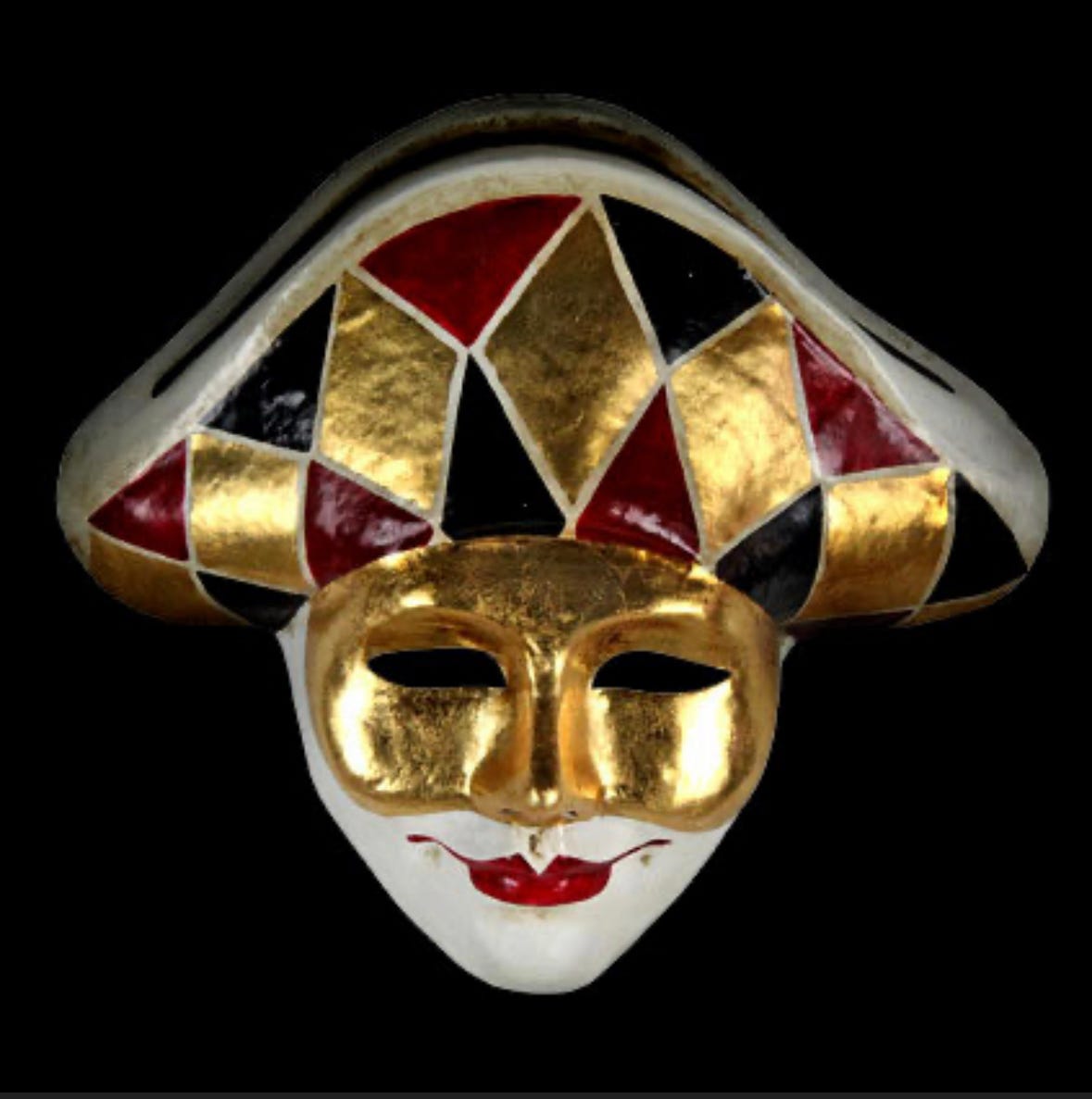The History and Art of Venetian Mask-Making for Carnival
There are many different traditions leading up to the beginning of the Christian fast of Lent, which the Catholic Church has practiced for considerably more than a thousand years to prepare for the celebration of Easter, Christ’s Resurrection. In the Eastern rites of the Catholic Church, the fasting season begins with Meatfare (the last day on which one can eat meat) and Cheesefare (the last day to eat dairy products) and thus gradually transitions into the “Great Fast.”
In the West, however, Lent begins on Ash Wednesday, which this year happens tomorrow, February 22. Some European nations and their cultural inheritors around the globe have traditions and customs of celebration and parties before Ash Wednesday, culminating on the Tuesday before Lent begins. “Mardi Gras” (Fat Tuesday) is famous in America through the celebrations of formerly French-owned Louisiana, but “Carnival” or “Carnevale” is important in Italy, too.
I had the wonderful experience of being in Siena for Carnival in 2020, but there’s one Italian city people usually associate most with Carnival: Venice. One of the most famous Carnival traditions celebrated in Venice is masquerading. Aside from elaborate costumes, Venetians traditionally don hand-crafted masks for Carnival. The making of these masks has been a true art form for hundreds of years, and I would like to highlight the historical context and traditional artistic process of creating these masks today.
First of all, a little history behind Venice’s Carnival celebrations and masks:
“The exact length of Carnevale has varied from era to era and among different regions. The first recorded observance of Carnevale in Venice was in 1296, and the celebrations grew to include competitions between the siestres (districts) of the city, bull races and slaughters, wrestling and gymnastic displays, parades leading to Piazza San Marco, quasi-religious ceremonies lead by the doge (duke, elected ruler of Venice), and elaborate costumes and masks.
In 1463, the mask-maker’s guild was established, and the ruling council began to issue laws restricting when, where, how, and who could wear masks. These pieces of information are how we infer the importance of masks to Venetian life. . .By the 16th century, Carnevale celebrations extended from December 26 until Lent began, and masks could be worn all during this time. Masks were also worn during the festival of [Jesus’s] Ascension. . .That mask-wearing period began 30 days [sic] after Easter1 and lasted until June. So about half the year could be spent masked!
Perhaps the oldest mask style is the simple domino or half-mask. This mask covers the eyes and part of the nose. While historical imagery is scarce, descriptions note that women often wore solid black masks and men would wear solid white masks. The early 17th-century engravings show very little decoration and usually on masks worn by musicians, dancers, and other entertainers.
The iconic Venetian mask, one found nowhere else during Carnevale, is the larva also called the volto, and it appears that this form originated in the 16th century. This mask covers half the face and is open below the nose to allow the wearer to eat, drink, and talk without being revealed. These masks were not decorated at all and [were] usually plain white. They were often worn with a hat and a veil attached to the mask, which gave a very secretive look. In the 18th century, this veil was first called the bauta (coming from names for lace, which it was often made of), and the veil was attached to a tricorn hat. Today, the names larva, volto, and bauta are sometimes used interchangeably for the same mask.
During the Italian Renaissance, as the arts flourished, so did the theater. Commedia dell’ Arte used stock characters with easily identifiable masks, behind which actors improvised satirical plays. Many characters evolved over time, but the earliest ones have masks that are still common.
Commedia dell’ Arte masks were often made of leather and formed to show exaggerated facial expressions. Arlecchino or Harlequin is a crafty servant character who wears a black mask with raised eyebrows [see above and below for two variations]. Pantalone is a miserly old man who wears a mask with a big nose and bushy eyebrows. These types of masks were not worn by the citizens of Venice, only by the performing actors.”
But mask-wearing became so much a part of everyday Venetian life that the city’s rulers were concerned. Unfortunately, they also had pretty extreme punishments in mind. But that didn’t stop mask-wearing.
“In 1608, the council decided that the casual mask-wearing was getting out of hand. A decree was issued that limited masks only to Carnevale and official banquets. Penalties for defying this law were severe: Men would suffer two years in jail and a 500 lire fine, while women would be whipped and held in public ridicule between the two columns at Piazza San Marco.
Of course, like many heavy-handed laws, this wasn’t successful, and mask-wearing continued to be popular in Venice throughout the 17th and 18th centuries. Venetian Carnevale was a major tourist destination for the European elite until the Republic fell to Napoleon’s army in 1797.
The masks were mostly cast aside for over a century, and not until the 1980s were the public Carnevale celebrations revived. Today, Venice’s mask-makers flourish again, and many have revived historical techniques — even if their creations are worn only for two weeks before Lent instead of months.”
We’re living in a society that too often attacks good traditions along with the bad, but cultural heritage is very important. Peoples who don’t know their past are more easily manipulated by ideologues in the present.
There are still craftsmen in Venice who make masks by hand, using traditional methods. Here are sections of a 2018 article2 on 21st-century Venetian mask-makers:
“For a true piece of Venetian history and art, look for a mask made in Venice by a company that uses traditional mask making techniques.
Family-owned Ca’macana is one such company. Mario Belloni and Antonella Masnata, both transplants from Genoa, started Ca’macana in the early 1980s after they moved to Venice, drawn in by the city’s beauty and harmony. . .More than thirty years later, they are still in that same workshop. . .They still make masks in the same manner they made them when they started using the traditional techniques Venetians have employed in mask-making for centuries.
It all starts with a block of clay. For Davide Belloni, Mario’s and Antonella’s son and now the General Manager of the company, this is the most difficult but also the most fascinating step of the process. . .To produce the right proportions, the Ca’macana artisans refer to photos, old paintings of masked people, or pre-made molds. Most work is done by hand although, at times, loop tools and other sculpting tools may be used. Depending on the complexity of the shape and the skill level of the mask maker, this step can take hours or days. . .
Once the clay prototype is ready, plaster is applied to its entire surface, creating what Davide refers to as a ‘sarcophagus’ around the mask.
When ready, the plaster sarcophagus is removed from its clay model, revealing all the intricate details of the future mask.
Ca’macana uses cartolana, wool paper, for their papier-mâché process. Containing a small percentage of wool, this paper is soft yet resistant. It doesn’t shrink and it keeps its form when it dries.
The mask maker wets the paper, covers it in glue, and then—strip by strip—applies it to the inside of the sarcophagus. It usually takes between three and four layers of paper to make a mask. It could take anywhere from 24 to 36 hours for a face-sized mask to dry, so Ca’macana uses a heater to speed up this process.
According to Davide, if a mask maker has done a good job, you can see junctions between different strips of paper but not feel them. The surface of the mask must be completely smooth to the touch.
Cleaning the eyes and correcting minor mistakes is the next step in the mask-making process.
Once the mask maker is satisfied with the shape, white acrylic paint is applied to the entire surface of the mask. . .
A mask often combines different techniques and different media. Either one or several artists work on one mask and all painting is done by hand.
Glazing is the last step in mask production. After the mask is glazed, either with a clear glaze or with a glaze that creates an antique effect, it’s set out to dry for several minutes.”
In a world where hand-crafted goods and historically-rooted art are getting more and more scarce, the mask-makers of Venice are keeping alive a beautiful tradition.
(This article is adapted from one I originally wrote last year.)
The Catholic feast of the Ascension officially occurs 40 days after Easter.
All images of the mask-making process and the final image of finished masks courtesy of Fodor’s Travel, Margarita Gokun Silver, and Ca’macana.












